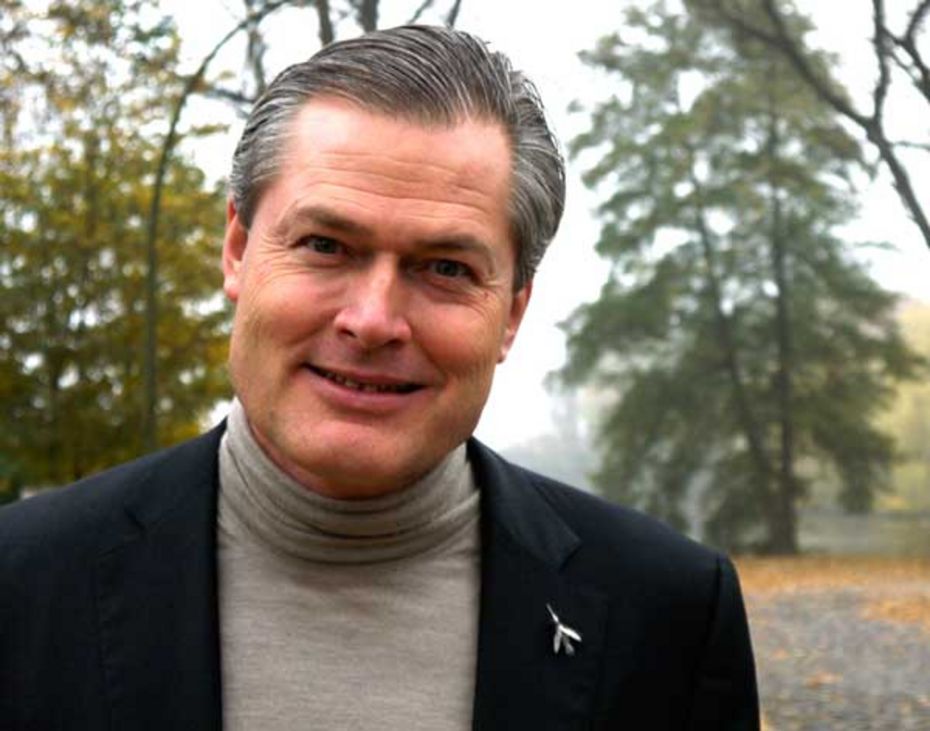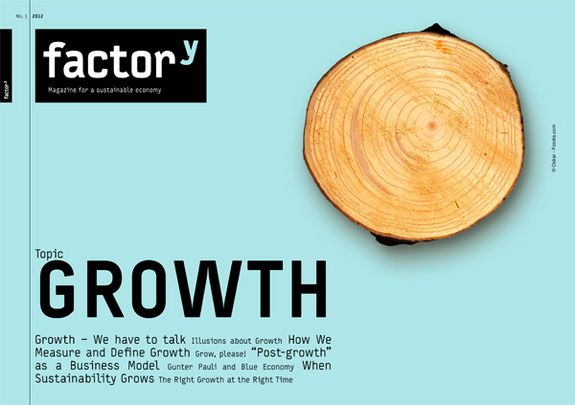Growth

Better quality for better prices is the objective of Blue Economy. Its inventor, Gunter Pauli, is an entrepreneur, advisor, author, travelling speaker and an educator. He wants to meet everybody's basic needs with his Blue Economics by using what is available regionally.
By Bert Beyers
Translated from the German by Christine Kuhn, Luzie Schmitt and Alina Junk
Your concept is called Blue Economy – why?
I have been working on promoting more environmentally friendly economic standards, a green economy, for 30 years. Ten years ago, I realised that everything that is good for people's health and the environment is expensive. It costs too much money. After the financial and economic crisis in 2008, I finally realised that green solutions are only good for those who have money; which is not a good thing. We should create an economy which can ensure that people's basic needs are met by using the means available to us. This is why I think Blue Economy has to emphasise innovation; we should be entrepreneurs, we should not divide society up into good and bad, and we should always choose the best option.
Why “Blue”?
When looking at earth from space, it is a blue planet, not a green one. There is the blue sky and the blue ocean, too.
If I understood you correctly, at Blue Economy, it is all about relations; between things and people, and on all levels you can imagine; it is about relationships and smart synergies, the kinds you might overlook at first sight. Can you give me an example of the Blue Economy?
Since we are sitting here having coffee one might wonder: What is that in my cup? The answer: Only 0.2 % of the material that coffee farmers in Colombia and Kenya harvested. Once again, only 0.2 % of the material is actually being used, and no one who drinks coffee has ever felt bad about wasting 99.8% of the material. Those who drink tea only use as little as 0.1 per cent of the material. There is something most people drinking coffee or tea don't realize: There is a large amount of waste material rotting away and turning into methane gas.
Are you talking about the left-over coffee grounds?
Coffee grounds, the husks, and all the other parts of the coffee plant that are not used. It is funny that the coffee's added value is based on the 0.2% in our cups. The rest is waste material. One of the largest processors of coffee is Nestlé, where about three million metric tons of coffee waste material is burnt in the course of the production of Nescafé. Three million metric tons are used as a source of energy. This is exactly how these processes are working now. They just didn't know any better when they first designed the production process. Thanks to research at the University of Hong Kong found in 1991 that one kilo of coffee grounds allows the cultivation of half a kilo of shiitake mushrooms. Twenty years ago, shiitake was not well known, but today it has been established as a highly nutritious mushroom with neither fatty acids nor cholesterol. In other words: a product we should be eating more of.
How does Nestlé respond to your ideas?
I met the former chairman of Nestlé, Helmut Maucher, in Davos. He told me he thought it was an excellent idea. We went on to look at the figures and I told him Nestlé could produce one and a half million tons of shiitake with its three million tons of coffee grounds. In about ten years Nestlé could become the largest producer of healthy mushrooms worldwide. This could put them in competition with China, which now already exports EUR 17bn worth of mushrooms.
So how did the project play out?
Nestlé said that their core business was selling coffee, not mushrooms. This means that they do not have the core competence needed for the mushroom sector. This is why they do not want to sell mushrooms. However, I would say that Nestlé has a supply chain management that should be able to handle this or they could outsource the task. But they had the impression that it would not be possible to place the product on the market.
But coffee and shiitake got together anyway.
Worldwide, already 15 000 employees work in the field of utilising coffee by-products. They work in Zimbabwe, Tanzania, Colombia and Brazil. However, coffee grounds are also produced in Europe. Ten top chefs in Berlin have decided that they want to grow 14 different types of mushrooms using these coffee grounds. There are agreements with La Place in the Netherlands, with the Kraft company in Paris, and with Starbucks in Madrid. The project is really taking off now. People today are aware of the fact that Europe is in the midst of a crisis which jeopardises jobs. Starbucks in Madrid has managed to create 60 additional jobs by means of added value.
How do you experience communication with companies?
Here is a Unilever example involving tomatoes: the skin of the tomato is full of colour pigments which Unilever could use directly in their own production processes. We have worked for years on this subject in order to explain how it works scientifically. Yet, when the company is finally ready, there will be other difficulties to tackle, that is to say reorganising the supply chain management. However, due to the risks attached to reorganising the supply chains, nearly none of the major companies would consider this step. The only one who could influence this is the financial director, with the argument that the cash flow could be increased.
How could this problem be solved?
When we talk to a company now – a month ago, for example, I met some of the major companies of the chemical sector in Madrid – I have to rewrite my speech, translate it into cash flow and stress the advantages for the balances. This usually leads to success on my side. Yet, if I only talk about the technical side, the problem is that the listeners are not well enough acquainted with the subject.
So it is about a common language basis.
I think we, as supporters of the green or blue economy, use a language that had up to now only been understood in the field of corporate social responsibility and sustainability but not in business. Therefore, we, as the ones who want innovation that leads us to a more sustainable society, need to adapt our language in order to make our arguments comprehensible for large companies. Showing Starbucks in Spain that they could upgrade their company brand by selling super healthy mushrooms and creating jobs at the same time, was not corporate social responsibility. For Starbucks, this presents a new approach towards changing their business model. Now Starbucks branches in other Spanish cities can no longer imagine not growing mushrooms. They realise that customers appreciate that they can get mushrooms for half the usual price. This is exactly what the blue economy is about: it has to be cheaper and we are able to create jobs. Our approach is to combine the two things.
How does blue economy see growth?
In my opinion, we should not blindly discuss growth. I have lived in South America and Asia and if one billion people worldwide are desperately poor, we simply need growth. Yet, this growth has to be different from the European or US-American idea of growth. We need a new concept of growth. For us, growth is primarily about providing for the basic needs of the entire population. To achieve this, we need to develop innovative business models. A sewage treatment plant costs money. A landfill costs money, too. Usually, people pay taxes to cover these expenses. This means that money is extracted from the economy to finance these disposal services. If we used a reasonable chemical method, as Korea does for example, we would be able to produce four times as much biogas by using sewage sludge and organic waste from the landfill. This is more than the best scientists have predicted. We talk about smart grids but not about smart chemistry.
In which categories do you think of growth?
Humans are the only species on this planet with a concept of lack. Other species have always had enough or even in abundance. And when there was not enough, species adapted. Yet, it is strange that we are the only species that maintains a linear idea of growth. A basic need is water, for example. However, this does not mean that we should waste 40 litres of water flushing a toilet like they do in the USA. This does not make any sense. What we should do instead is develop more toilets that only require one and a half litres to flush, and reclaim the water afterwards. The whole debate about growth is a sham: are you in favour of it or against it? This is not the right question. The question should be: what is the best solution?
More on this:
News zum Thema
- 10/2016 | European Resources Forum (ERF) on 9 – 10 November 2016
- 10/2016 | Environmental tax reform for climate protection and social justice
- 07/2016 | Planetary Urbanism – The Transformative Power of Cities in 50 Selected Works
- 11/2015 | The Hope for COP
- 10/2015 | If a major economy takes the lead, warming could be limited to 2°C
- 06/2014 | 2013 is another Record Year for Renewables
- 05/2014 | "Growth" issue now available
- 10/2013 | Germany could be greenhouse-gas-neutral by 2050
- 01/2013 | For a Better Energy Efficiency Policy
- 01/2013 | A New Way of Assessing our Economies: The Prosperity Quintet
Themen
- The Domino Effect: the Mobility Transition as an Engine for the ‘Great Transformation’
- Cities Use the Space
- Decarbonization by 2030
- The fear of biting the hand that feeds you
- Where investing is a pleasure
- Why divestment is going to change the world
- A Robin Hood tax for climate protection
- May the Force Be with Us
- Modern Strategies
- The prerogative of interpreting the future now lies with the companies involved in climate protection”
- From Negotiating to Trading Equitably
- Can a donkey be tragic?
- Rethink rather than rebound: a sufficiency revolution must precede the efficiency revolution
- On Rebound, Prebound and Performance Gaps
- So Let Us Seize Power Then!
- With Common Property Against Political Failure
- So Let Us Seize Power Then!
- The Comforting Beauty of Failure
- “It Is Not Impossible at All.“
- Resource-light shopping
- Men Have Not Stopped Giving the Advantage to Women – So Far
- Toothpaste for Princesses and Soup for Pirates
- It is about equality
- A nice day
- Initiative instead of frustration
- The right ingredients
- Resilient for Life
- Not only, but also
- Appreciation – more please!
- Worth more than money
- Learning to value the value of goods
- Worth and Values
- The Transformative Power of Science
- Historically effective: How innovation and technology transform
- The Disappearance of Products
- Growing Older 101
- Columbus’ Egg
- It Works! In Theory at Least ...
- What If...?
- Analysing Separately – Thinking and Acting Together!
- Let’s Break Away from Determined Breaking Points
- More Gold in Waste than in Mines
- The art of separation
- Should you really DIY?
- The Aesthetics of Do-It-Yourself
- Standing on One’s Own Feet
- From the handaxe to desktop fabrication
- Using Shares to Survive the Crisis
- When Citizens participate
- Possess to Participate
- The Right Growth at the Right Time
- Gunter Pauli and Blue Economy
- When Sustainability Grows
- How we treat Growth
- Illusions about Growth



